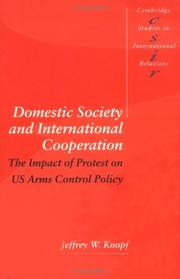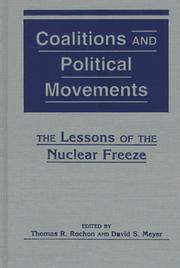| Listing 1 - 7 of 7 |
Sort by
|
Book
ISBN: 9780804778275 Year: 2012 Publisher: Stanford, Calif. Stanford Security Studies
Abstract | Keywords | Export | Availability | Bookmark
 Loading...
Loading...Choose an application
- Reference Manager
- EndNote
- RefWorks (Direct export to RefWorks)

ISBN: 0511005679 9780511005671 0521622409 0521626919 Year: 1998 Volume: 60 Publisher: Cambridge, U.K. New York Cambridge University Press
Abstract | Keywords | Export | Availability | Bookmark
 Loading...
Loading...Choose an application
- Reference Manager
- EndNote
- RefWorks (Direct export to RefWorks)
Nuclear arms control --- Antinuclear movement --- Security, International. --- Security, International --- Law, Politics & Government --- International Relations --- Collective security --- International security --- International relations --- Disarmament --- International organization --- Peace --- Nuclear weapons control --- Arms control --- Nuclear weapons --- Government policy --- Armes nucléaires --- Mouvement antinucléaire --- Sécurité internationale --- Contrôle --- Politique gouvernementale
Book
ISBN: 0804784914 9780804784917 9780804778275 0804778272 Year: 2012 Publisher: Stanford, Calif. Stanford University Press
Abstract | Keywords | Export | Availability | Bookmark
 Loading...
Loading...Choose an application
- Reference Manager
- EndNote
- RefWorks (Direct export to RefWorks)
While policy makers and scholars have long devoted considerable attention to strategies like deterrence, which threaten others with unacceptable consequences, such threat-based strategies are not always the best option. In some cases, a state may be better off seeking to give others a greater sense of security, rather than by holding their security at risk. The most prominent use of these security assurances has been in conjunction with efforts to prevent the spread of nuclear weapons.Ongoing concerns about the nuclear activities of countries like Iran and North Korea, and the pos
Nuclear nonproliferation. --- National security. --- Security, International. --- Collective security --- International security --- International relations --- Disarmament --- International organization --- Peace --- National security --- National security policy --- NSP (National security policy) --- Security policy, National --- Economic policy --- Military policy --- Export of nuclear materials --- Export of nuclear technology --- International control of nuclear energy --- Nonproliferation, Nuclear --- Nuclear energy --- Nuclear exports --- Nuclear proliferation --- Proliferation, Nuclear --- Nuclear arms control --- Nuclear-weapon-free zones --- Government policy --- International control
Book
ISBN: 0820348910 9780820348919 9780820345277 082034527X Year: 2016 Publisher: Athens University of Georgia Press
Abstract | Keywords | Export | Availability | Bookmark
 Loading...
Loading...Choose an application
- Reference Manager
- EndNote
- RefWorks (Direct export to RefWorks)
International efforts to prevent the spread of weapons of mass destruction (WMD)-including nuclear, biological, and chemical weapons-rest upon foundations provided by global treaties such as the Nuclear Non-Proliferation Treaty (NPT) and the Chemical Weapons Convention (CWC). Over time, however, states have created a number of other mechanisms for organizing international cooperation to promote nonproliferation. Examples range from regional efforts to various worldwide export-control regimes and nuclear security summit meetings initiated by U.S. president Barack Obama. Many of these ad
Nuclear nonproliferation. --- National security. --- Security, International.
Book
ISBN: 082035564X 9780820355641 9780820355634 0820355631 Year: 2019 Publisher: Athens
Abstract | Keywords | Export | Availability | Bookmark
 Loading...
Loading...Choose an application
- Reference Manager
- EndNote
- RefWorks (Direct export to RefWorks)
"Recent discoveries in psychology and neuroscience have improved our understanding of why our decision making processes fail to match standard social science assumptions about rationality. As researchers such as Daniel Kahneman, Amos Tversky, and Richard Thaler have shown, people often depart in systematic ways from the predictions of the rational actor model of classic economic thought because of the influence of emotions, cognitive biases, an aversion to loss, and other strong motivations and values. These findings about the limits of rationality have formed the basis of behavioral economics, an approach that has attracted enormous attention in recent years. This collection of essays applies the insights of behavioral economics to the study of nuclear weapons policy. Behavioral economics gives us a more accurate picture of how people think and, as a consequence, of how they make decisions about whether to acquire or use nuclear arms. Such decisions are made in real-world circumstances in which rational calculations about cost and benefit are intertwined with complicated emotions and subject to human limitations. Strategies for pursuing nuclear deterrence and nonproliferation should therefore, argue the contributors, account for these dynamics in a systematic way. The contributors to this collection examine how a behavioral approach might inform our understanding of topics such as deterrence, economic sanctions, the nuclear nonproliferation regime, and U.S. domestic debates about ballistic missile defense. The essays also take note of the limitations of a behavioral approach for dealing with situations in which even a single deviation from the predictions of any model can have dire consequences"--
Economic policy --- Military policy --- Nuclear nonproliferation. --- Deterrence (Strategy) --- Nuclear weapons --- Economics --- Atomic weapons --- Fusion weapons --- Thermonuclear weapons --- Weapons of mass destruction --- No first use (Nuclear strategy) --- Nuclear arms control --- Nuclear disarmament --- Nuclear warfare --- Behavioral economics --- Behavioural economics --- Psychology, Military --- Strategy --- First strike (Nuclear strategy) --- Nuclear crisis stability --- Export of nuclear materials --- Export of nuclear technology --- International control of nuclear energy --- Nonproliferation, Nuclear --- Nuclear energy --- Nuclear exports --- Nuclear proliferation --- Proliferation, Nuclear --- Nuclear-weapon-free zones --- Economic nationalism --- Economic planning --- National planning --- State planning --- Planning --- National security --- Social policy --- Decision making. --- Government policy. --- Psychological aspects. --- Economic aspects. --- International control
Book

ISBN: 9781685858179 1685858171 Year: 2023 Publisher: Boulder
Abstract | Keywords | Export | Availability | Bookmark
 Loading...
Loading...Choose an application
- Reference Manager
- EndNote
- RefWorks (Direct export to RefWorks)
How advanced is our knowledge about the dynamics of political and social activism? What lessons can be learned by studying the rise and fall of particular political and social movements? What insights can be gained by applying the different frameworks and methodologies of political science, sociology, and communications? This original work employs multidisciplinary perspectives to better understand the nuclear freeze, a movement that at one time produced a vast national network of activism and the largest political demonstration in the history of the United States. Incorporating a new, coalitional theory of political and social movements, the authors explore the successes and failures of the freeze campaign in its attempts to influence legislation, treaties, and public opinion about nuclear weapons. They examine freeze activism in the context of the larger peace movement, its continuing relevance for current and future peace mobilizations, and its implications for the general study of political and social change.


ISBN: 9781685858179 9781555877446 Year: 2023 Publisher: Boulder Lynne Rienner Publishers
Abstract | Keywords | Export | Availability | Bookmark
 Loading...
Loading...Choose an application
- Reference Manager
- EndNote
- RefWorks (Direct export to RefWorks)
| Listing 1 - 7 of 7 |
Sort by
|

 Search
Search Feedback
Feedback About UniCat
About UniCat  Help
Help News
News